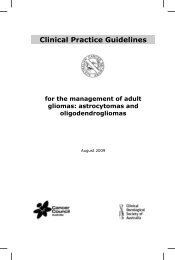Clinical Practice Guidelines for the management of locally advanced ...
Clinical Practice Guidelines for the management of locally advanced ...
Clinical Practice Guidelines for the management of locally advanced ...
You also want an ePaper? Increase the reach of your titles
YUMPU automatically turns print PDFs into web optimized ePapers that Google loves.
APPENDIX 1 GUIDELINE DEVELOPMENT PROCESS<br />
A1.1 Introduction<br />
The Australian Cancer Network (ACN) initiated a proposal to develop <strong>the</strong> <strong>Clinical</strong> practice guidelines<br />
<strong>for</strong> <strong>the</strong> <strong>management</strong> <strong>of</strong> <strong>advanced</strong> prostate cancer. A decision to proceed was taken in September<br />
2005. To better describe <strong>the</strong> scope <strong>of</strong> <strong>the</strong> guidelines, <strong>the</strong> title was changed to <strong>Clinical</strong> practice<br />
guidelines <strong>for</strong> <strong>the</strong> <strong>management</strong> <strong>of</strong> <strong>locally</strong> <strong>advanced</strong> and metastatic prostate cancer.<br />
A Working Party composed <strong>of</strong> clinical specialists and consumers and a project team based in <strong>the</strong><br />
Cancer Epidemiology Research Unit <strong>of</strong> Cancer Council New South Wales, carried out <strong>the</strong> work. The<br />
project team conducted literature searches, assisted in <strong>the</strong> critical evaluation <strong>of</strong> <strong>the</strong> literature and<br />
extracted <strong>the</strong> relevant data. Financial support was provided by Andrology Australia, <strong>the</strong> Prostate<br />
Cancer Foundation <strong>of</strong> Australia and ACN. NHMRC appointed a Guideline Assessment Reviewer<br />
(GAR) to both monitor and aid <strong>the</strong> development process.<br />
The development program was designed to meet <strong>the</strong> scientific rigour required by <strong>the</strong> guideline<br />
development process, which is <strong>the</strong> subject <strong>of</strong> a series <strong>of</strong> handbooks on <strong>the</strong> main stages involved in <strong>the</strong><br />
development <strong>of</strong> clinical practice guidelines. 1–8 These handbooks have been previously condensed into<br />
a single volume—Development <strong>of</strong> clinical practice guidelines <strong>for</strong> <strong>the</strong> <strong>management</strong> <strong>of</strong> cutaneous<br />
melanoma and melanoma in special sites: a handbook <strong>for</strong> chapter leaders and expert working<br />
groups 9 —which outlines <strong>the</strong> major steps and expectations involved in developing guidelines and<br />
provided a clear path <strong>for</strong> everyone involved in <strong>the</strong> project. This handbook provides <strong>the</strong> definitions and<br />
protocols <strong>for</strong> developing research questions and search strategies, conducting searches and critical<br />
appraisal, summarising and assessing <strong>the</strong> relevant literature and finally, <strong>for</strong>mulating <strong>the</strong><br />
recommendations. It includes checklists and templates created to satisfy designated standards <strong>of</strong><br />
quality and process. These condensed handbooks have been a most useful aid in <strong>the</strong> demanding and,<br />
<strong>for</strong> some, new process <strong>of</strong> developing guidelines.<br />
At its initial meetings <strong>the</strong> <strong>Guidelines</strong> Working Party prepared a table <strong>of</strong> topics and developed<br />
questions to address identified clinical needs. The questions were divided into different topics and<br />
subcommittees <strong>of</strong> <strong>the</strong> <strong>Guidelines</strong> Working Party were <strong>for</strong>med to address topics in <strong>the</strong>ir areas <strong>of</strong><br />
expertise.<br />
A2.1 Steps in preparing clinical practice guidelines to<br />
NHMRC criteria<br />
A clear strategy was developed <strong>for</strong> every topic and each expert group followed <strong>the</strong> appropriate steps<br />
in preparing <strong>the</strong> guidelines. While each subcommittee received significant assistance from <strong>the</strong> project<br />
team skilled in methodology, <strong>the</strong> subcommittees <strong>the</strong>mselves oversaw <strong>the</strong> syn<strong>the</strong>sis <strong>of</strong> <strong>the</strong> evidence<br />
and <strong>for</strong>mulation <strong>of</strong> <strong>the</strong> recommendations <strong>for</strong> <strong>the</strong>ir topics.<br />
The strategic steps followed are outlined below:<br />
1. Structure <strong>the</strong> research questions<br />
2. Develop a search strategy<br />
3. Search <strong>the</strong> literature<br />
4. Select, assess and summarise <strong>the</strong> literature<br />
5. Critically appraise and summarise each selected article<br />
6. Assess <strong>the</strong> body <strong>of</strong> evidence and <strong>for</strong>mulate recommendations<br />
117<br />
Appendices



